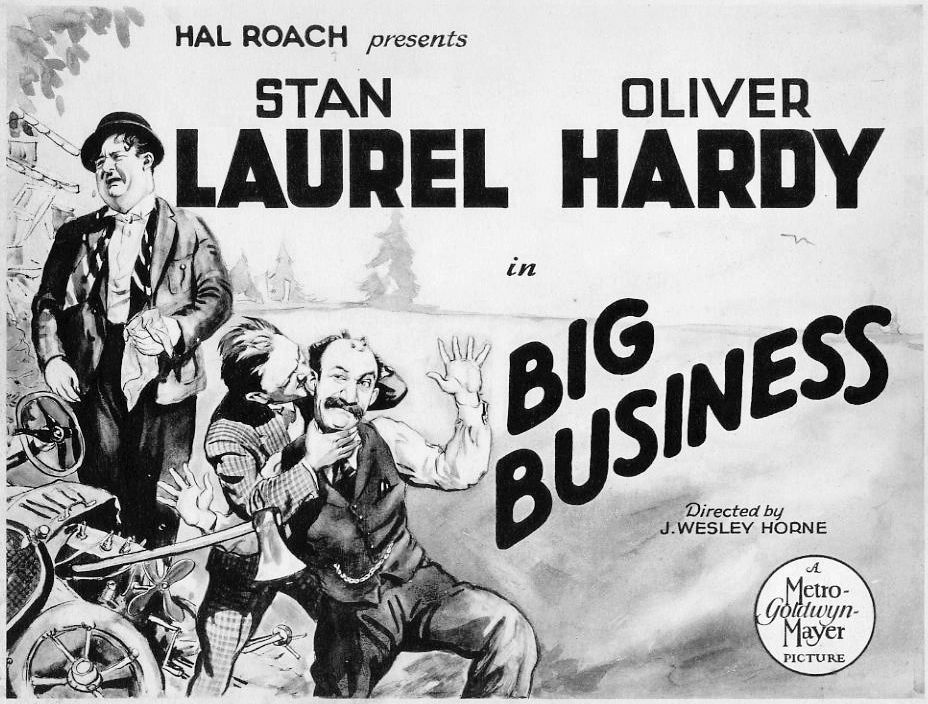Running a group of shorts in chronological order at a show isn’t always ideal. For a film class where you’re looking to present a segment of a body of one comedian’s work in the order in which is made, then perhaps yes. For a show, though, you want a progression.
You can almost follow the basic four-movement structure of a typical string quartet, maybe one of Haydn’s, or of a symphony. Start off strong, something that will help a novice audience easily retune it’s mental tuner to the world of silent film and know it’s okay to laugh. Number two can be pretty much anything, then the number three can be the one that’s a little slower or that is more introspective, character-driven or focused on smaller details. One A.M., The Blacksmith, The Finishing Touch, or pretty much anything with Langdon, for example.
Usually this formula works for me when I assemble a program of comedy shorts. But I’ve noticed something about the way a couple of Laurel & Hardy comedies go over in the last few years that have made me now re-think What Goes Last on a Stan and Ollie silents show.
I listen to the audience at all the shows I play, but really listen. Listen, and react, and sometimes adjust the score. I’m aware of how a film goes over, and how it goes over the same way with multiple audiences.
For instance, I’ve done so many school shows of Keaton’s One Week that when I began including it for groups of sixth graders at programs held during an annual silents fest in Norway, I noticed that the kids were laughing at the same places and the same way as everybody else. I had the same reaction playing for Steamboat Bill, Jr. in Jecheon, South Korea a few years ago. You can hear some of the music and reaction in this episode of my podcast.

For many years, I’ve ended Laurel & Hardy silents shows with one of the reciprocal destruction films. They’ve got the build, energy and physical comedy that you want in a good closer. And they’ve always ended a show with a bang. Two Tars and Big Business are two of the more iconic of the boys’ silents. Big Business is a perennial favorite at the end of the year because it involves Christmas trees. It’s on the National Film Registry. These are the films that pretty much originated in cinema the slow-and-steady comedy of one person standing there while the other destroys something of theirs, looking at them and saying “is that so?”, and then doing something back.
These have always been good closers. But in the last few years I’ve noticed that audiences haven’t been laughing at them quite as heartily and heavily. Definitely, funny — there are laughs in all the right places, and the audience has a great time, but I’m sensing something with that sixth sense you develop as a film accompanist.
Perhaps the mean-spirited-ness that’s behind the two shorts isn’t sitting right with people at the moment or isn’t resonating the same way. Don’t get me wrong. I adore these two shorts, and You’re Darn Tootin’ as well. And they all definitely get their laughs. But for a big finish, maybe for a little while anyway, closing with Wrong Again, which absolutely kills at every show I do, is the way to go. I’ve usually had that in the number three slot, followed by BB or 2T but maybe, like the “just the reverse” gesture Stan and Ollie keep making in Wrong Again, I should try flipping the two in the show order and see what happens. I could be wrong, and your show results may vary.
Listen to my spoken introduction in Korean and English (I had a translator), some music and reflections on the show I did in front of 3,000 people at the Jecheon International Music and Film Festival on episode 19 of my Silent Film Music Podcast
I have composed an orchestral score for Laurel & Hardy in Wrong Again, commissioned for the Boise Philharmonic Chamber Ensemble, and it’s available for orchestras.
Start strong, end strong, and you can be a little weaker in the middle. When I was booking Stooge programs at Sony, I always insisted they end with either IN THE SWEET PIE AND PIE or AN ACHE IN EVERY STAKE, which guaranteed a bang-up finish.